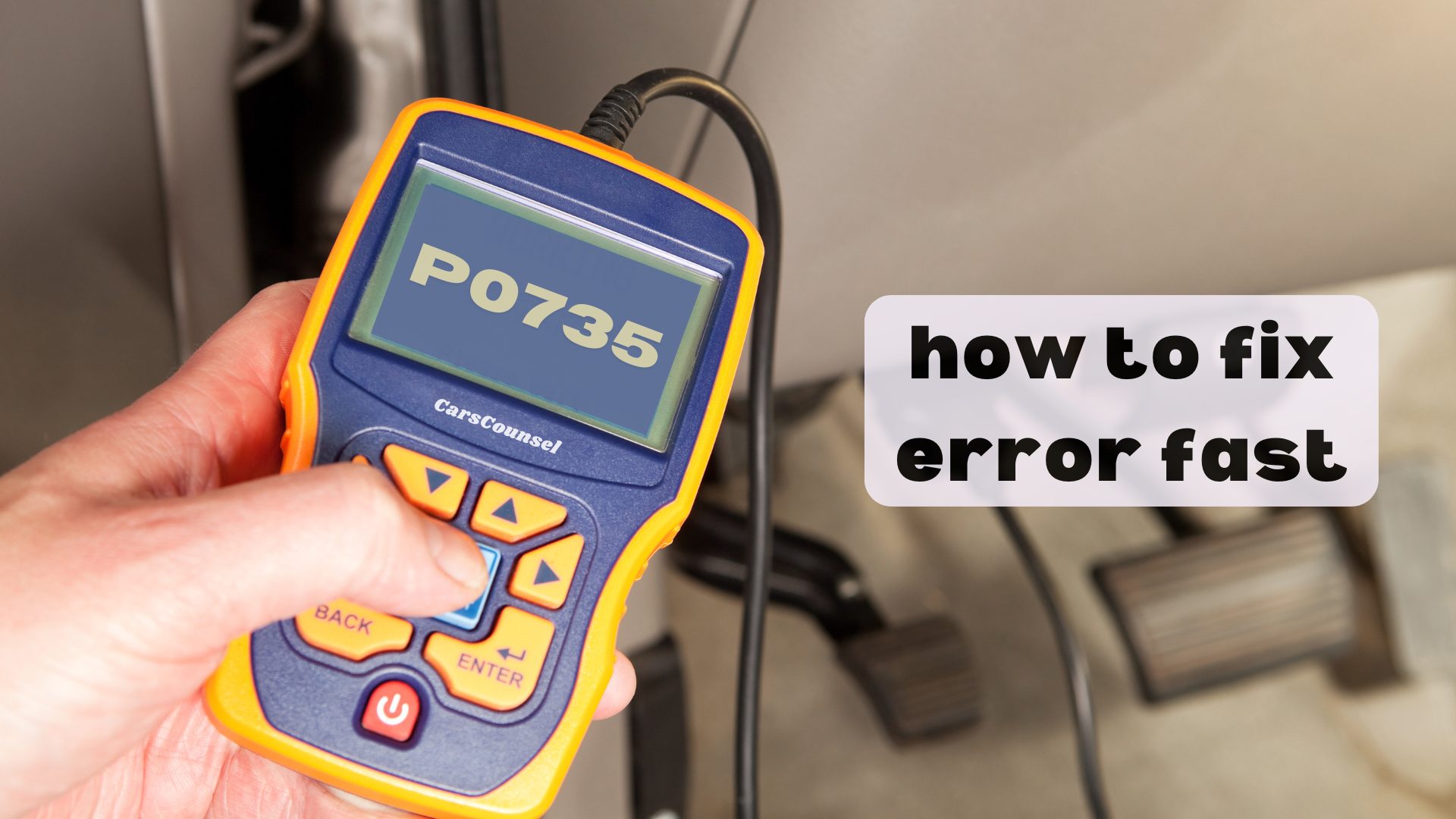Did you know that over 30% of transmission problems are due to faulty shift solenoids, which can set off a P0735 code?
If you see this code, don’t worry—there are easy steps you can take to fix it quickly. From checking your transmission fluid to testing the shift solenoid and inspecting the wiring, you can troubleshoot this issue without needing to see a mechanic.
But before you dive into the fixes, it’s important to understand what this error code means and how it affects your car’s performance.

Quick Navigation
Key Takeaways
- Check the transmission fluid and add more if it’s low or looks dirty.
- Use an OBD2 scanner to read and clear the P0735 code.
- Check the shift solenoids and replace them if they’re not working properly.
- Look for damaged or loose wires and fix them if needed.
What Is P0735 Code?
Understanding the P0735 code is important because it means your car’s automatic transmission is having trouble shifting into 5th gear due to a gear ratio mismatch. This happens when the actual gear ratio doesn’t match what it should be.
It usually points to problems like faulty shift solenoids, low transmission fluid, or issues with the transmission control module (TCM). These gear problems can make driving less smooth and might cause long-term damage if not fixed quickly.
Symptoms of P0735 Code
When your car’s transmission has trouble shifting into 5th gear due to a P0735 code, you’ll probably notice things like poor acceleration, slipping gears, and strange noises coming from the transmission area. These symptoms can really mess with how your car runs and might cause warning lights to show up on your dashboard. You might also feel the car shifting gears erratically.
Here’s a quick look at common P0735 symptoms:
| Symptom | Description | Impact on Vehicle |
|---|---|---|
| Poor Acceleration | Slow response to the gas | Reduced performance |
| Slipping Gears | Unintended gear changes | Unstable transmission |
| Unusual Noises | Grinding or whining sounds | Potential mechanical damage |
| Warning Lights | Dashboard indicators | Immediate attention needed |
Fixing these issues quickly is important to keep your car running well.
Common Causes of P0735
A P0735 code means there’s an issue with the transmission in your vehicle. This can happen for several reasons:
- Faulty Shift Solenoid: The shift solenoid controls the flow of transmission fluid. If it’s not working right, the car might have trouble shifting gears.
- Low Transmission Fluid: If the fluid is low, often because of a leak or not enough maintenance, the gears might slip or not engage properly.
- Bad Transmission Control Module (TCM): The TCM manages the shifting of gears. If it’s failing, the car might shift erratically.
- Wiring Problems: Loose or damaged wires can cause communication issues with the TCM, leading to shifting problems.
It’s important to address these issues quickly to avoid more damage to the transmission.
Impact on Vehicle Performance
Fixing the problem that causes a P0735 code is really important because it messes with how well your car runs. When this code pops up, your transmission doesn’t work as it should, especially when trying to shift into fifth gear.
You might notice your gears slipping, less power, and worse gas mileage. This happens because the transmission can’t keep the right gear ratio, making the engine work harder than it needs to.
If you ignore it, you could end up with a completely broken transmission, leaving your car undriveable. Taking care of it right away not only gets your transmission working well again but also stops bigger, more expensive problems from happening.
Diagnosing P0735 Code
To diagnose the P0735 code, start by using an OBD2 scanner to read and clear any trouble codes.
First, check the transmission fluid level and its condition since this is a basic part of transmission upkeep.
If the fluid level is okay, test the shift solenoid with an ohmmeter to make sure it’s working right.
Look over the wiring for any signs of damage or loose connections that could be causing issues.
Use detailed diagnostic tools to check for electrical shorts or bad connections.
You might need to run several tests to figure out the exact problem.
Using an OBD2 Scanner
Using an OBD2 scanner is essential for quickly finding and fixing the P0735 code in your car’s transmission system. This tool is really useful because it can read and clear error codes, show real-time data, and help you find problems with the transmission’s gear ratio.
But it’s important to know that an OBD2 scanner has its limits. While it can spot a P0735 code, it won’t tell you exactly what’s causing the problem or how to fix it.
You’ll still need to do more checks, like looking at the shift solenoid, wiring, and transmission control module (TCM).
Even with these limits, an OBD2 scanner is a great first step in solving transmission issues quickly.
Checking Transmission Fluid
Checking Transmission Fluid
After you see the P0735 code, the next thing to do is check the transmission fluid level and condition. Keeping your transmission in good shape is key for your car to run well. Here’s how to do it:
- Find the Dipstick: Look for the transmission dipstick, which is usually marked and easy to find.
- Pull Out and Clean the Dipstick: Take the dipstick out and wipe it clean. Make sure the engine is warm before you do this.
- Reinsert the Dipstick: Put the dipstick all the way back in and wait a few seconds.
- Check the Fluid Level: Pull the dipstick out again to see if the fluid level is within the normal range.
- Look at the Fluid Quality: Check the color and smell of the fluid. Clean, red fluid is good. If it’s dark or smells burnt, you may have a problem.
Regularly checking and maintaining the transmission fluid can help you avoid expensive repairs and keep your transmission running longer.
Testing Shift Solenoid
How do you make sure your shift solenoid is working right?
First, find out what type of shift solenoid your vehicle has since different models might use different ones.
Use an ohmmeter to check the solenoid’s resistance; it should be what the manufacturer specifies. If it’s not, the solenoid is likely bad.
If you find a problem, you need to replace the shift solenoid. Disconnect the battery, find the solenoid in the transmission, and swap it out for a new one.
Make sure all connections are tight before putting everything back together.
Properly testing and replacing a bad shift solenoid can fix the P0735 code, get your transmission working normally again, and prevent further issues, keeping your vehicle running well.
Wiring and Electrical Issues
Wiring and electrical problems can lead to the P0735 code by messing up the communication between the transmission control module (TCM) and the transmission system.
To fix this, start by looking at the vehicle’s wiring diagrams. These diagrams will help you follow the electrical paths and spot any potential issues. Check for signs of wear, corrosion, or loose connections.
Electrical shorts are often the problem; they can cause erratic signals and disrupt the TCM’s operations. Carefully inspect the wiring harness and connectors to ensure all connections are tight and undamaged.
Use a multimeter to check for continuity and short circuits. Properly diagnosing and fixing wiring issues will restore good communication, clearing up the P0735 code.
Repair Costs and Options
To fix the P0735 code, you’ll need to look into different repair options and their costs.
Start by checking and adding more transmission fluid, which might cost less than $100.
If the shift solenoid or sensors are broken, replacements usually cost between $100 and $300.
If there’s a problem with the Transmission Control Module (TCM), expect to pay between $200 and $800.
More complicated internal repairs can cost over $1,000.
Always get quotes from several mechanics to find the best price.
Remember, regular maintenance like checking fluid levels can help prevent future issues.
Costs will vary based on your vehicle’s make, model, and where you live, so plan ahead.
Getting a proper diagnosis ensures you only pay for what’s needed.
More OBD-II Codes
Frequently Asked Questions
Can Driving With a P0735 Code Cause Long-Term Damage to My Car?
Driving with a P0735 code can seriously damage your transmission over time. Fix it right away to avoid expensive repairs. Ignoring it could lead to total transmission failure, which will affect how your car runs and its safety.
How Often Should Transmission Fluid Be Checked to Prevent P0735?
To avoid transmission problems like P0735, you should check your transmission fluid once a month. Regular maintenance and changing the fluid on time will keep your transmission working well and help you avoid expensive repairs and long-term damage.
Are There Preventive Measures to Avoid Transmission Issues Like P0735?
To avoid transmission problems like P0735, make regular maintenance a priority. Frequently check the transmission fluid, replace it when necessary, and look for any leaks. Fix small issues right away to prevent bigger problems and keep your transmission working well.
Can Aftermarket Parts Affect the Likelihood of a P0735 Code Appearing?
Yes, using aftermarket parts can impact your transmission’s compatibility and raise the chances of a P0735 code appearing. Make sure aftermarket parts meet the same quality as original parts to avoid problems. Poor-quality parts can cause shifting issues and errors.
Is It Safe to Drive Short Distances With a P0735 Code Active?
You might think short drives are okay, but with a P0735 code, driving isn’t safe. Your transmission problems can get worse fast, leading to potential breakdowns. It’s best to fix the issue right away to avoid more damage.
Conclusion
To fix the P0735 code quickly, first confirm the error with an OBD2 scanner.
Then, check the transmission fluid and replace it if needed.
Test the shift solenoid and inspect the wiring for any damage.
Addressing these issues right away can prevent more expensive repairs later.
By following these steps, you’ll get your vehicle’s transmission working properly again.

